

March is here; its the first day of Spring!
This week, The English Apple Man attended AHDB Tree Fruit Day on Thursday and today (Friday) with colleagues judging the National Fruit Show Juice competition.
The ADHD Tree Fruit Day held at NIAB/EMR on Thursday 28th February was an opportunity for the scientists working on various AHDB (Agriculture & Horticulture Development Board) research projects to update growers and industry representatives with the latest research results.
AHDB Horticulture, formerly Horticultural Development Company (HDC), was established in 1986 with a remit to fund research and development and communicate results to growers. In 2003, it was also given responsibility for near-market R&D for the apple and pear industry.
For extensive information on the structure and objectives of the AHDB click on AHDB
Introducing the speakers and Chairing the day's event, AHDB Communications Director Scott Raffle welcomed the attendees to the annual tree fruit event.
The programme consisted of 12 presentations, delivered by 11 scientists.
This week The English Apple Man will report on one item; 'Optimum planting material for fruit wall production systems'
The research project has been featured before in EAM Journals but this was an opportunity to review the elements involved in the different trial aspects.
Below: Extract from March 2016
Materials & Methods
The 5 year trial was established in 2012 with Gala as the chosen variety; planted at distances of 3.5 metres x 0.5 metre in the row, there are 5 treatments & 5 sub treatments, with 4 replicate rows of 20 trees per plot.
How are fruit wall cut timings determined?
Assessments are made of Leaf counts - measuring Shoot length and leaf numbers, Yield, Fruit maturity at harvest - Fruit quality, Leaf Mineral Analysis and Fruit Dry Matter.
Conclusions reached demonstrate later cuts had better growth control; there were no significant effects on 2015 yield, fruit size, weight, maturity, Brix (sugars), firmness or dry Matter.
Fruit colour improved on 9 & 6 leaf cuts; winter hand pruning produced the highest cumulative total yield - percentage of Class 1 fruit highest for inter pruned Pink Bud. Inter tree pruning; lower total yields but increased C1 - Cropping wood in mechanically pruned plots is increasing.
The trial process for 'tree wall mechanical pruning' requires finding the optimum stage for making the cuts; the stages are determined by the number of leaves on the new (young) vegetative growth; e.g. when 6 leaves are formed or 9 leaves are formed
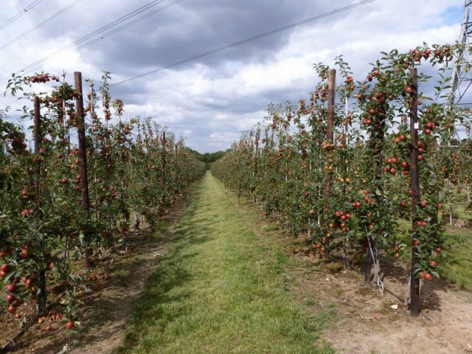 Grower Action Points
Grower Action Points
Abi stressed the importance of assessing the orchard before any pruning takes place; where tree control is the major consideration, delayed pruning is advised. The optimum fruit wall timing is yet to be determined.
Financial Benefits
There is a potential for reducing pruning costs and skilled pruning labour requirements. The cumulative yield was reduced for later cut fruit wall conversion. This is when conversion from a standard hedgerow system is converted - either by a winter cut (preferred) or by conversion by summer cuts
Abi thanked - AHDB - Adrian Scripps Farms - Parsonage Farm Staff and FAST LLP Trials Team, Advisors & Laboratory personnel for their contribution to the TF207 FRUIT WALL TIMING project.
LATEST RESEARCH - FRUIT WALL PRODUCTION SYSTEMS
Next Abi Dalton reviewed the TF206 FRUIT WALL TYPE project.
Introduction and Background - Fruit wall concept - adapt trees - Project outline, 2015 is the second fruiting year and Abi reviewed how the trees are adapting?
Materials & Methods
This is a 5 year trial commencing in 2014, using Gala - Planting distances 3.5m x 0.8m - 5 tree type treatments and 6 replicate rows of 10 trees per plot.
The five tree types:1 Year 5 + Branches: 1 Year unfeathered: 2 Year Old: Standard Knip: Twin Stem:
The objective here, is to assess how each tree type performs as a fruit wall when grown from a young tree, rather than the 'conversion' of established trees used in TF207 FRUIT WALL TIMING
How are fruit wall cut timings determined?
By assessments of leaf counts, yield and class, fruit physiology and quality and tree physiology
Conclusions
Significant effect on yields, fruit weight and tree volume; it is not yet clear whether responses are due to establishment of the different tree types or pruning. It is not yet conclusive which tree type most suited to fruit wall system!
Grower Action Points
The 'Fruit Wall' cut was carried out when 9 new leaves had emerged on current season's growth. It is important to make regular leaf counts to establish growth stage before pruning. Abi said other actions points will be determined in the remaining 3 years of the trial.
Financial Benefits
Abi Dalton summarised; "There is potential for reducing pruning costs and skilled pruning labour requirements, but it is too early to cost the future savings".
The English Apple Man Comments: "the future system will be a taller, narrower hedge row format than the systems common at the turn of the century; whether mechanical pruning becomes the standard is yet to become clear - the increase in labour unit costs is going to be a huge challenge; the availability of labour may well become an equal challenge to our future. The key to it all is not just the cost of pruning, but profit per acre/hectare which is determined by yield, quality, and particularly, consumer attraction - e.g. price of the fruit back to the grower
2019
At the AHDB Tree Fruit Day, Abi Dalton - FAST trials manager presented the latest data as the Project comes to a conclusion.
The choice of tree types at planting were: 1. One year old tree with 5 branches. 2. One year old unfeathered tree. 3. Two year old tree. 4. Standard knip tree. 5. Twin stem tree.
Below: Tree wall information and right; tree types
Below: left; tree wall pruning dates over the 5 years and right; grower action points
Below: left; accumulated yields for each tree type and right; yield efficiency data
Below: left; tree wall summary and right; financial benefits
Below: Conclusions
The English Apple Man Comments:
The trial has been worthwhile!
While the project does not appear to have defined mechanically pruned fruit walls as more successful than hedge row systems managed in the conventionally pruned way, or which tree type is the best, much has been learned; there are growers who have used mechanical pruning as a tool to be used as part of the tree management system, and not purely as a tool to reduce pruning costs.!
The rapid development of tree management systems on a global basis, is taking us towards very narrow profile tree shapes - 2 dimensional or multi stem formats are almost certainly the future. Trials are important in putting into practice tree different tree management systems.
Today, The English Apple Man joined colleagues for the annual National Fruit Show Juice Competition tasting of a collection of juices entered by makers of apple and other fruits into commercial fruit juices.
Below: Tasters at work
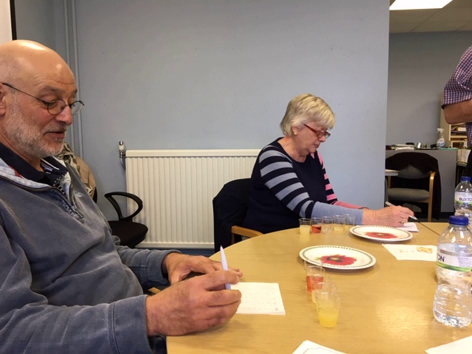
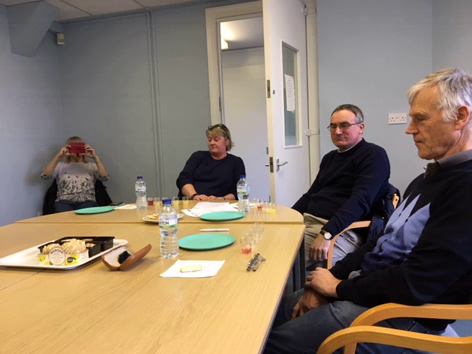
Below: left; Samples of juice may be apple, pear, or other fruits - raspberry and cherry among them and right; 'head Honcho' David Pennell gathers the judges scores
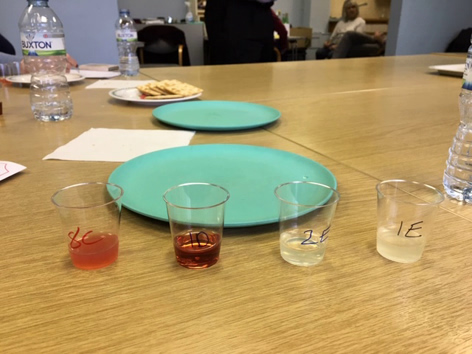
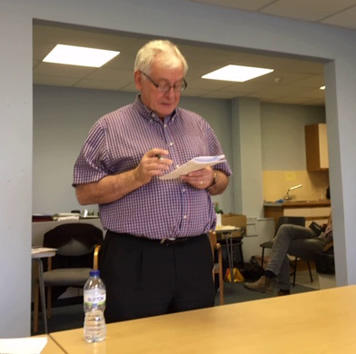
The results of the NFS Juice Competition will be announced at the Marden Fruit Show AGM on 24th April.
That is all for this week
Take care
The English Apple Man